“The Galileo Seven”
Written by Oliver Crawford and S. Bar-David
Directed by Robert Gist
Season 1, Episode 13
Production episode 6149-14
Original air date: January 5, 1967
Stardate: 2821.5
Captain’s log. While en route to deliver emergency medical supplies to Makus III, where they’ll meet another ship to take those supplies to the plague-ridden New Paris colony, the Enterprise‘s course takes them near Murasaki 312, a quasar-like formation. Kirk has standing orders to investigate any such phenomena, so he sends Spock in the shuttlecraft Galileo along with six others—McCoy, Scotty, Lieutenants Boma, Gaetano, and Latimer, and Yeoman Mears—to do scientific research on Murasaki.
High Commissioner Ferris—on board to supervise the delivery of the medicine—is opposed to this diversion, but Kirk points out that they’re two days ahead of schedule for their rendezvous at Makus, so there’s plenty of time. (Insert dramatic irony music here…)
The Galileo launches, but radiation from Murasaki affects readings and disrupts the instruments. They lose control and are pulled off course. Their message to the Enterprise is garbled, and sensors don’t work at all within the quasar. There are four star systems within Murasaki, and no way to know which one—if any—the shuttle’s headed for.
Uhura reports that there’s a Class-M planet in Murasaki, the second planet in the Taurus system. Kirk orders course set for that system.
The Galileo has, indeed, crashed on Taurus II. Boma theorizes that the magnetic field of Murasaki pulled them in. McCoy tends to folks’ injuries, while Scotty does damage control. Spock sends Gaetano and Latimer to survey the area. Spock speaks honestly to McCoy: the Enterprise will have a bitch of a time finding them since their instruments won’t work in the quasar, and it’s a really big planet, assuming they even know where to look.
Kirk is told that transporters aren’t functioning at 100% and they can’t risk beaming people, so Kirk sends the shuttlecraft Columbus out to do a visual search. Ferris is obnoxious and smug—but also right—when he says “I told you so” to Kirk, and makes it clear that he won’t let Kirk continue the search a second past the point where they might miss their rendezvous.
Scotty reports that they don’t have enough fuel to achieve escape velocity, and even if they did, they couldn’t achieve orbit without losing 500 pounds. Boma wants to know who’ll decide which three people are left behind, and Spock says he will as CO, somehow without adding the word “duh.”
During their survey, Gaetano and Latimer are ambushed by a native, who throws a big-ass spear right into Latimer’s back. Spock examines the spear, causing Boma to bitch him out for being more concerned with the type of weapon used than who it was used on. Gaetano also requests that they don’t leave Latimer’s body out there.
Latimer’s death has solved one problem: now they only need to lose 325 pounds of weight, and Mears and McCoy manage to find enough excess equipment to bring that number down to 175—but that still means someone has to stay behind. Spock also declines to lead the service for Latimer, leaving it to McCoy.
Scotty’s attempt to bypass the busted fuel line fails, and they lose all fuel—which, Spock dryly points out, solves the problem of who to leave behind. Then more natives can be heard gathering nearby. Boma recommends that they hit them hard, give them a bloody nose so they’ll think twice about attacking. Spock agrees with the logic, but is appalled by the notion of attacking them. Instead, he believes they should fire to frighten, not kill—these people will never have seen anything like phasers before, and they should scare them off.
Leaving McCoy and Mears to assist Scotty, Spock, Boma, and Gaetano go off to frighten the natives. Upon their return—Spock confident that they’re scared off—Scotty suggests an alternate fuel source: the phasers. He can dump the power from the weapons into the shuttle. Spock agrees, and collects everyone’s phasers, pointing out their time crunch: in 24 hours, the Enterprise will depart for their rendezvous, and they’ll be screwed.
The engineering crew gets the transporters to function in the magnetic soup, and so Kirk adds landing parties beaming to various locations to aid the Columbus in its search. Meanwhile, Gaetano is killed by a native. When searching for him, Spock, Boma, and McCoy come across his phaser, which Spock immediately gives to McCoy to bring back to Scotty—along with Spock’s own in case he doesn’t come back. Boma and McCoy continue to be appalled by Spock’s lack of emotionalism (because, I guess, they haven’t met him?), and go give their phasers to Scotty.
Spock finds Gaetano’s body and carries it back to the shuttle, being menaced by the natives along the way as they toss spears at him. Spock is confused—his gambit of frightening the natives didn’t work, it just made them more aggressive. One native starts pounding the roof of the shuttle with a rock. Scotty needs another hour to finish his work. As the pounding continues, Spock tries to figure out where he went wrong, as he’s been so totally logical, yet two people are dead, the surviving landing party is pissed at him, and they’re being attacked. McCoy tartly reminds him that analysis can wait until later, and can we have some action, please? So he tells Scotty to use the batteries to electrify the hull, which sends the natives scurrying.
Boma insists on giving Gaetano a proper burial, which he says he’d insist on even if it was Spock who was dead—which even McCoy thinks is a step too far. Spock, however, agrees, assuming the natives don’t attack.
One of the Enterprise landing parties was also attacked, killing one crewmember and injuring three more. Just as sensor crews report that they can get readings, they hit the deadline. Ferris assumes command and orders Kirk to recall all landing parties and the Columbus. Kirk reluctantly does so, leaving Murasaki at space-normal speed to keep scanning as long as possible.
Scotty finishes his work, and they take off—but they need to use the boosters to do so, which means there’s no chance of a controlled landing. If the Enterprise doesn’t detect them after one orbit, they’ll burn in the atmosphere.
Spock decides to eject the fuel and ignite it, hoping that the Enterprise might detect that more readily than their tiny shuttle. Of course, Spock is fairly certain the Enterprise has already buggered off to their rendezvous, so it is probably a waste of time, but at least it’ll be over quickly at that point. In fact, they start to descend into the atmosphere rather quickly, with the instruments smoking, the characters all drenched in sweat, and Mears winning the Captain Obvious award with her statement, “It’s getting hot!”
However, Spock’s gamble works—Sulu picks up his improvised flare, and the five survivors are beamed out just before the Galileo burns up. Later, after McCoy tells Kirk what happened, the captain tries and fails to get Spock to admit that he committed a wholly human emotional act. Spock insists that he arrived at the desperate act logically, and agrees with Kirk’s assessment that he’s stubborn. This prompts hoots and gales of laughter from the rest of the crew, because that’s totally the appropriate thing to do after a mission where two people died…
Can’t we just reverse the polarity? Scotty comes up with the notion of dumping energy from the phasers into the shuttle engines to use as fuel. Because he’s just that awesome.
Fascinating. Given what McCoy describes as his first command situation (though he’s been in the chain of command of a starship for more than a decade at this point, I find it hard to credit that he’s never been in command of a mission before), Spock proceeds exclusively from logic, to inconsistent effect. He’s a poor leader of his human subordinates, and two of the crew are killed, at least one of which could have been prevented (Gaetano’s; Latimer’s likely would’ve happened no matter what, given that their tricorders were useless in Murasaki). When things get dicey, he spends a bit too much time trying to figure out where he went wrong and not enough taking action to make things right—though he eventually gets his head out of his ass and does so.
I’m a doctor not an escalator. This episode is the first real workout of the McCoy-tries-to-get-Spock-to-admit-to-feelings dynamic, as the good doctor pokes Spock with a stick any number of times.
Ahead warp one, aye. Sulu points out to Kirk that widening the Columbus search radius by 1% will leave a lot of land uncovered, which the captain knows, but he’s desperate to cover as much ground as quickly as possible. Sulu’s also the one who detects Spock’s improvised flare.
I cannot change the laws of physics! While McCoy, Boma, and Gaetano are busy snarking off Spock, Scotty is actually doing his job, focused entirely upon getting the Galileo fixed.
Hailing frequencies open. Uhura pretty much takes over Spock’s role on the bridge, serving as the conduit to Kirk for the rest of the crew, including finding the one Class-M planet in the quasar and coordinating the attempts to make sensors and transporters work right.
Go put on a red shirt. Gaetano is wearing gold, but he acts very much like a security guard—he’s certainly killed just like one. Latimer is the shuttle pilot, and he’s the first to go, as does a member of one of the search teams.
Channel open. “Mr. Spock, life and death are seldom logical.”
“But attaining a desired goal always is, Doctor.”
McCoy and Spock summing up their opposing worldviews.
Welcome aboard. In addition to recurring regulars DeForest Kelley, James Doohan, George Takei, and Nichelle Nichols, we’ve got Don Marshall (Boma), Peter Marko (Gaetano), Phyllis Douglas (Mears, the first of a lengthy series of post-Rand yeomen), and Reese Vaughn (Latimer) as the rest of the titular shuttlecraft team. Douglas will return in “The Way to Eden” as one of the “space hippies.”
John Crawford kicks off the bureaucrat-who-annoys-our-captain cliché as Ferris, Grant Woods plays Kelowitz, and Buck Maffei plays the big scary native.
David Ross returns as the transporter chief, having played a security guard in “Miri.” On those occasions when he was credited, he was either Galloway or Johnson, but here he’s just “transporter chief.” He’ll next be in “The Return of the Archons.”
Trivial matters: The story was pitched by Oliver Crawford as a science fictional version of Five Came Back, a 1939 film that co-starred a young Lucille Ball (co-owner of Desilu Studios, which produced Star Trek).
The part of Mears was originally written for Rand in the script, but was rewritten to a new character after Grace Lee Whitney was fired.
This is the first appearance of shuttlecraft on the Enterprise, the existence of which would’ve been handy in “The Enemy Within.” All the shuttlecraft miniature shots from this episode will be reused in future appearances of the shuttles, and despite its being destroyed, all future shuttlecraft will also be the Galileo (though the model in “The Way to Eden” will have a “II” added to the name). This episode is the only appearance of the Columbus, which is seen only once, using the Galileo miniature.
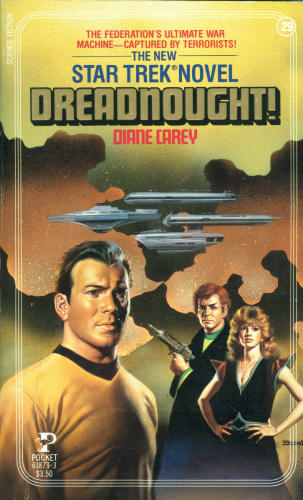 Boma appears in the novels Dreadnought! by Diane Carey (in which Scotty presses charges against him for insubordination and he’s discharged from Starfleet), the Janus Gate trilogy by L.A. Graf, and That Which Divides by Dayton Ward. Ferris is given a background in the FASA Four Years War RPG module.
Boma appears in the novels Dreadnought! by Diane Carey (in which Scotty presses charges against him for insubordination and he’s discharged from Starfleet), the Janus Gate trilogy by L.A. Graf, and That Which Divides by Dayton Ward. Ferris is given a background in the FASA Four Years War RPG module.
In addition to the usual adaptation by James Blish (in Star Trek 10), this episode was adapted into fotonovel form as part of Bantam’s series of fotonovel adaptations of episodes. In addition, the events of this episode are seen in the alternate timeline of the JJ Abrams films in issues #3-4 of IDW’s ongoing Star Trek series by Mike Johnson, Stephen Molnar, & Joe Phillips.
The 2007 remastering of this episode was one of the most extensive, redoing the visuals of the Murasaki quasar and of the planet of Taurus II (with the quasar’s effects more visible even in orbit), the Galileo‘s flare getting a better treatment, and actually seeing the shuttle burn up in the atmosphere as the landing party’s beamed off.
This is the first time the term “Class-M” is used to describe a planet with oxygen/nitrogen atmosphere (Earth-like, basically). The TV show Enterprise will establish that the term derives from a Vulcan designation of “Minshara class.”
To boldly go. “Mr. Spock, you’re a stubborn man.” Let us examine the myth of James T. Kirk as a maverick who always bends the rules when he isn’t breaking them, a guy who goes his own way and snubs his nose at authority.
Which is a myth, and 100% an artifact of the Trek movies. It started with him bullying his way back into command in The Motion Picture and his cheating on the Kobayashi Maru test in The Wrath of Khan, but the primary culprit is The Search for Spock, when Kirk steals the Enterprise to save Spock.
Here’s the thing: the whole point of the plot of the third film was that it was an extreme case, that saving Spock’s life was important enough to do something so unthinkable as disobey orders.
Prior to this, the only time Kirk truly disobeyed orders was in “Amok Time”—again, when Spock’s life was at stake. Basically the only reason Kirk would be anything other than a good soldier is to save the life of his best friend. (Technically, he also disobeyed orders in “The Doomsday Machine,” but he was disobeying the orders of a commodore who was obviously bugnuts and in no shape to be commanding anything, least of all Kirk’s ship.)
And yet, since 1984, the book on Jim Kirk has been that he breaks the rules, that he goes his own way, that he’s a maverick. That image has taken root in every interpretation of the character since then, whether in screen, prose, or comics form, taken to its absurd extreme in the JJ Abrams films, where Kirk’s entire history is distorted by the death of his father.
Part of that is mistaking his autonomy for being a rule-breaker, but that misses the point. In many situations in the original series (“Balance of Terror” being a good example), he’s out on the frontier on his own and has to make his own decisions. But that’s more a case of Kirk being the one to more or less make the rules because he’s totally on his own.
This episode is one of the prime examples that I like to cite when people mistakenly characterize Kirk as a maverick. Kirk not only follows regulations in this episode, he follows them doggedly and without thought to potential consequences. There’s a plague on New Paris, and the Enterprise is carrying medicine needed by hundreds of people—and he stops to examine a quasar? Really? Murasaki 312 has been there a really long time, would it not have made more sense to note its position, finish the mission of mercy, and then go back and play with the quasar? We’re talking something the size of four star systems, so realistically they’d need a helluva lot more than the two days Kirk had to examine it properly.
Kirk’s justification? He has standing orders to investigate quasars and quasar-like phenomena. Okay, then. Not exactly the actions of a go-your-own-way maverick, now is it?
What’s most notable about this episode is that the characters who we’re supposed to be rooting for—Kirk, Boma, Gaetano, McCoy—are the ones who come across the most unlikeable, while the “bad guys”—Spock for not being human enough, Ferris for being a bureaucratic snot—are actually the sympathetic ones. Spock may not be very human, but the pointed ears and the funny eyebrows and the green blood should be a clue as to why that really isn’t a consideration with him. The “why can’t you act like normal people” argument made by McCoy and Boma especially is frankly pretty ugly (and even more ironic coming in part from a character played by an African American). And for all that Ferris embodies what will become the Trek cliché of the obdurate bureaucrat, the fact of the matter is that Ferris is absolutely right. Kirk never should have stopped to stare at the quasar. Kirk’s served in space long enough to know that Murphy’s Law is the order of the day out in the black, and two days isn’t enough time to do anything useful, nor enough time to fix an unexpected problem.
I was always grateful to Diane Carey for establishing in her novel Dreadnaught! that Scotty hauled Boma up on charges, because holy cow, what a tool that guy is. His behavior toward Spock is insubordinate and insulting, and it gets to the point that even McCoy says he’s going too far. And his insistence on things like a “proper” burial (it’s only proper in some cultures) when there are ten-foot-tall anthropoids throwing spears at you is such an extreme case of sentiment over rationality that it makes Boma out to be an idiot. Admittedly, a lot of this is 1966 Hollywood attitudes, where middle-class white male Protestant values were considered the apex of humanity and anything else was deviant or weird, but it doesn’t make it any easier to stomach watching it now.
Where the episode shines is as a vehicle for Spock. As established in “The Naked Time” and “The Enemy Within,” Spock’s human and Vulcan natures are constantly at war with each other, and when he’s put in command, he wants very much for the Vulcan side to be dominant. He obviously thinks the Vulcan philosophy of logic is superior to that of the more emotional and sentimental human philosophy. To his credit, he later sees where logic falls down, particularly in ascribing motives to the natives—but we also see the good parts of it, like his unwillingness to blithely kill the natives despite Gaetano and Boma’s urging.
I do wonder what all those people were doing there. This was supposed to be a two-day scientific survey of the quasar. Latimer was there to fly the ship, and one assumes Boma was there for his scientific expertise (he’s the one with a theory about why the Galileo lost control and crashed), and Mears was there to record everything, but what were Gaetano, Scotty, and McCoy there for? I guess McCoy in case someone got hurt, but Scotty mainly seems to be there to fix the shuttle—but that’s only necessary because it crashed. And Gaetano’s job is never specified.
Oh, well. There are bits of a good episode here, but too often the script’s intended effect and actual effect are at odds with each other.
Warp factor rating: 5
Next week: “Court Martial”
Keith R.A. DeCandido‘s short story collection Without a License is now on sale from Dark Quest Books. It includes nine stories from throughout his twenty-plus years of writing, plus brand-new tales in the Dragon Precinct and Cassie Zukav milieus. You can order the trade paperback from Amazon, Barnes & Noble, or directly from the author; the eBook edition will be on sale soon.










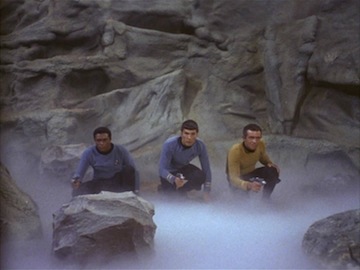

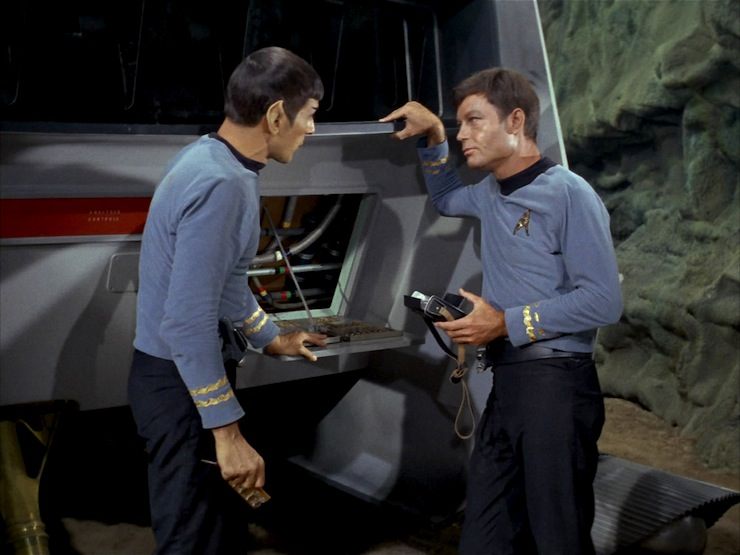
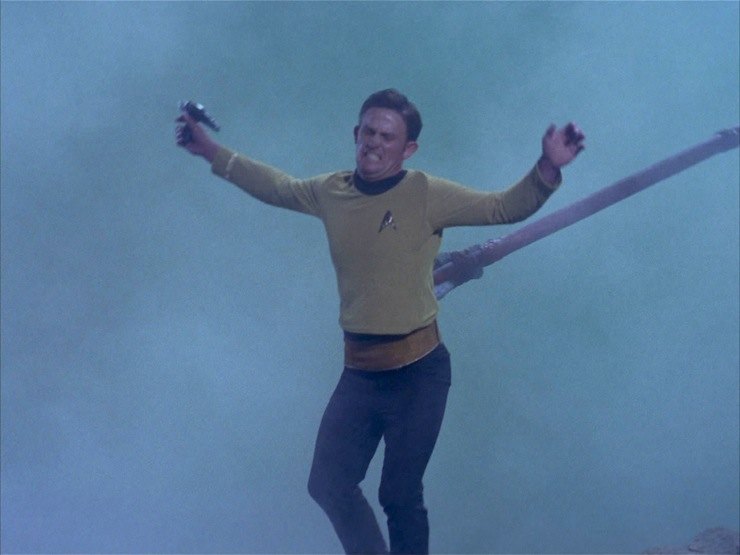
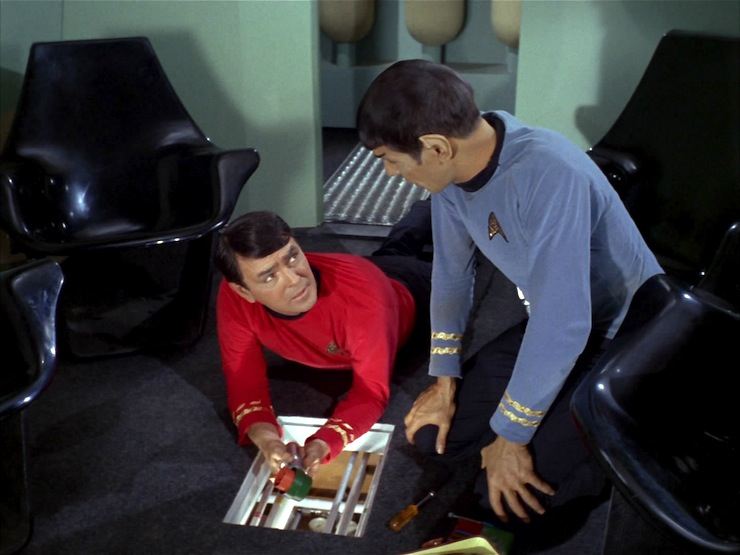
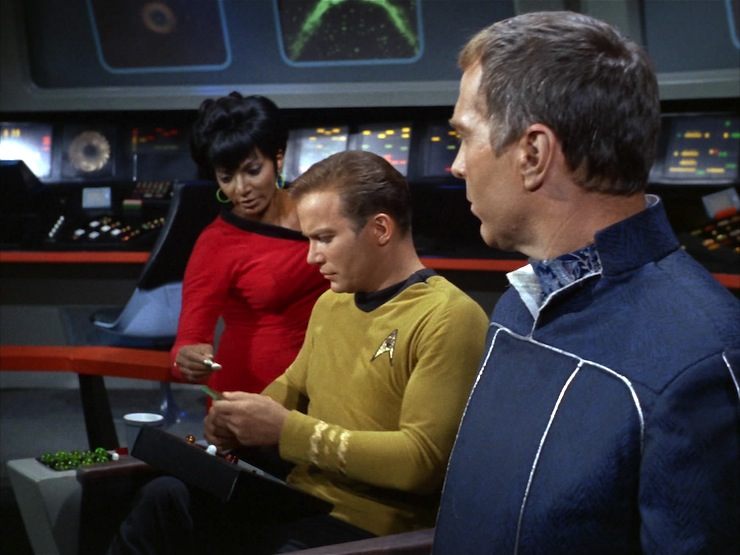
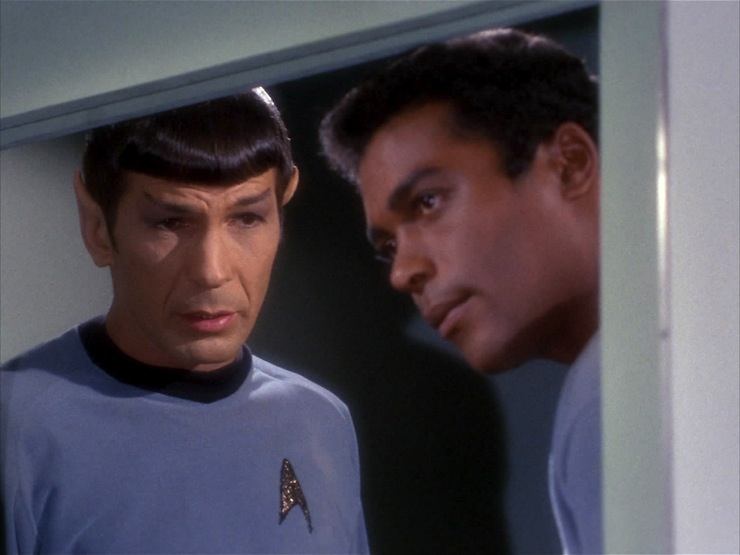
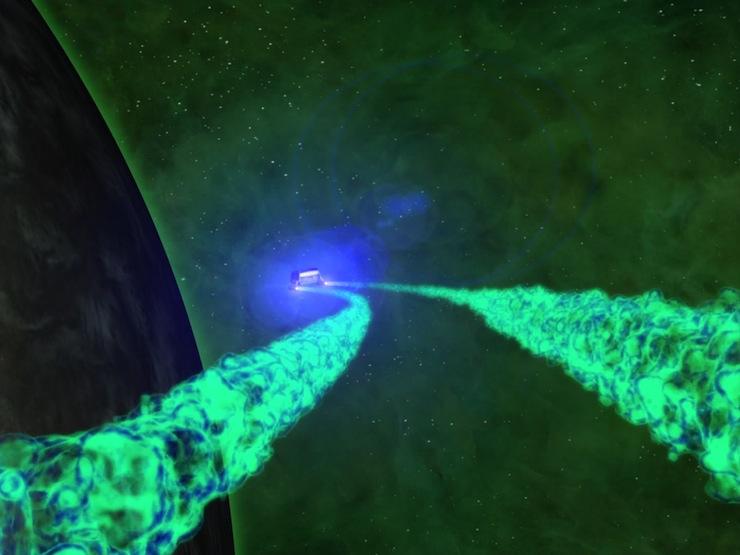
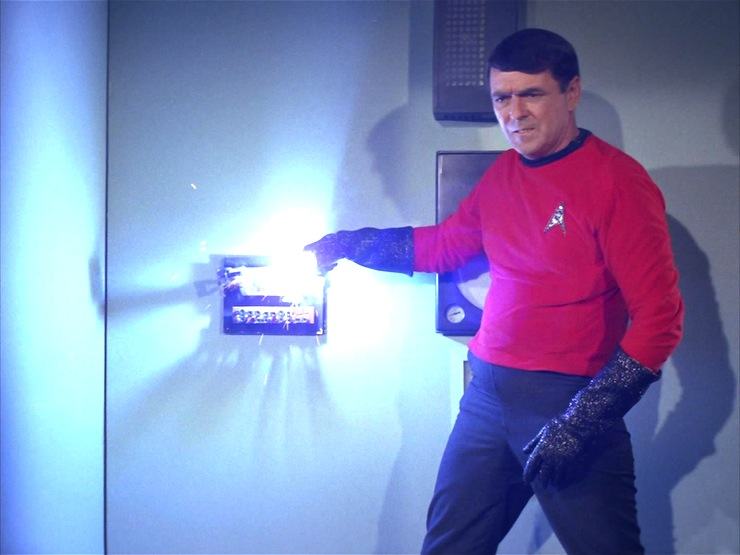
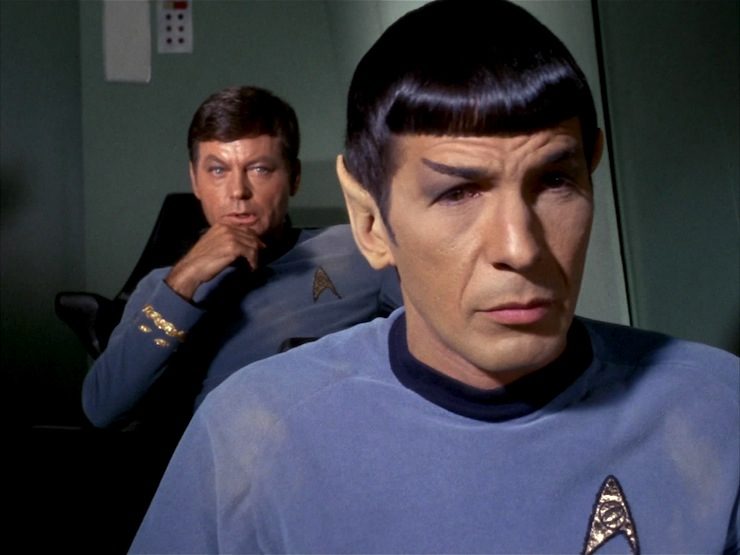
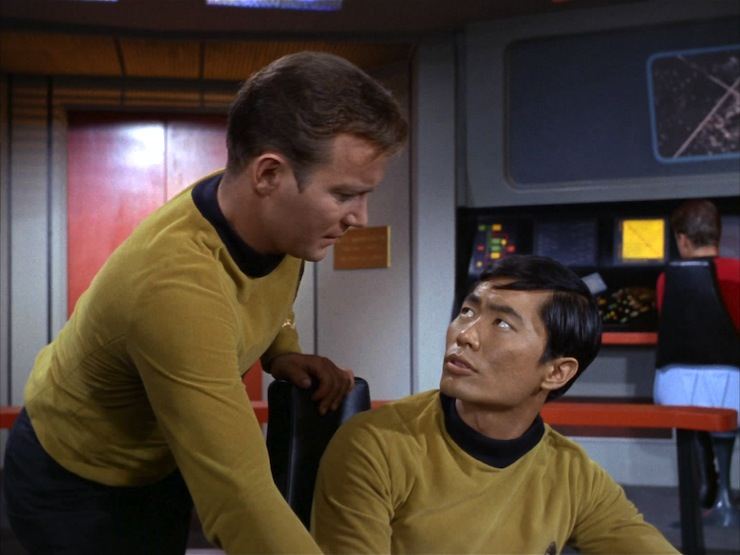
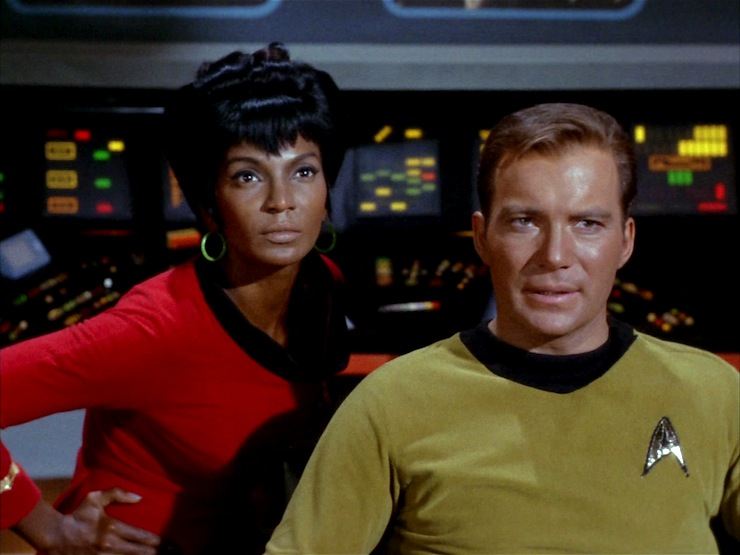
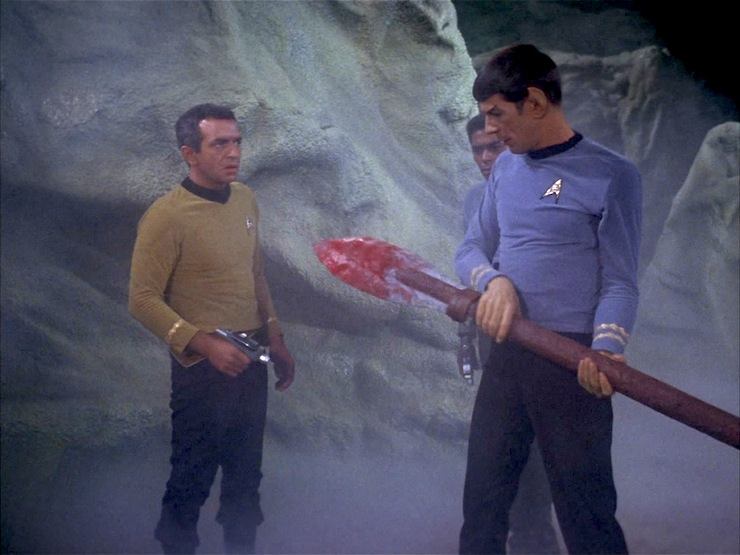
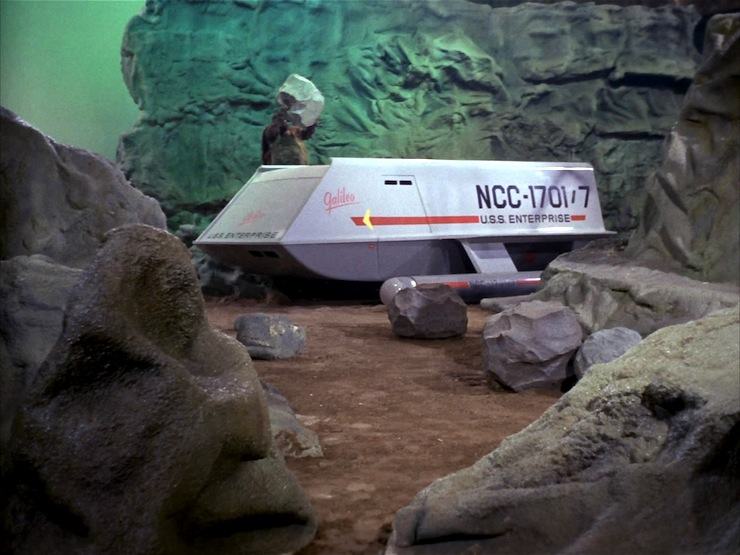
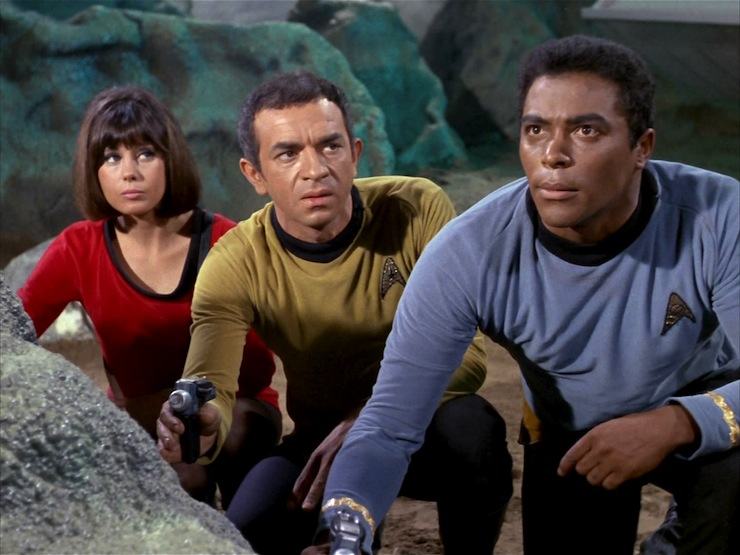
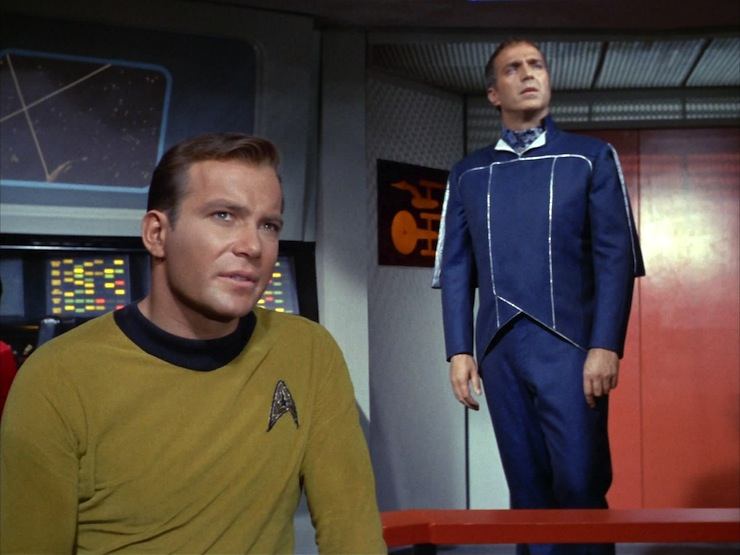

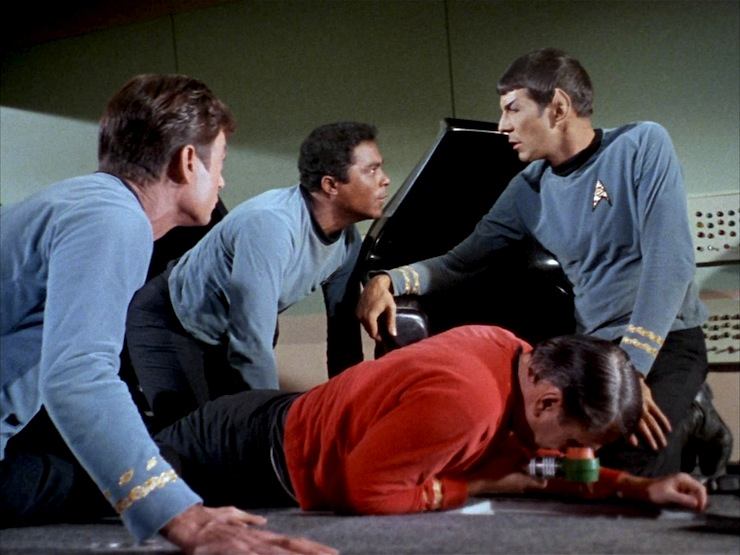
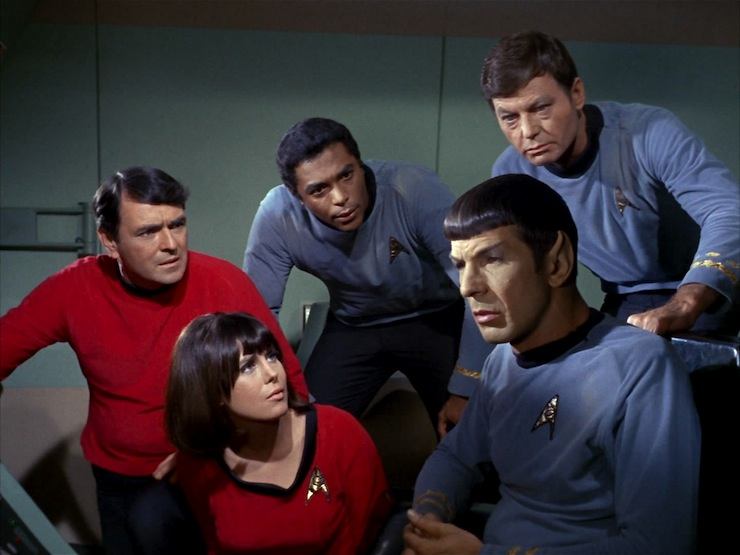
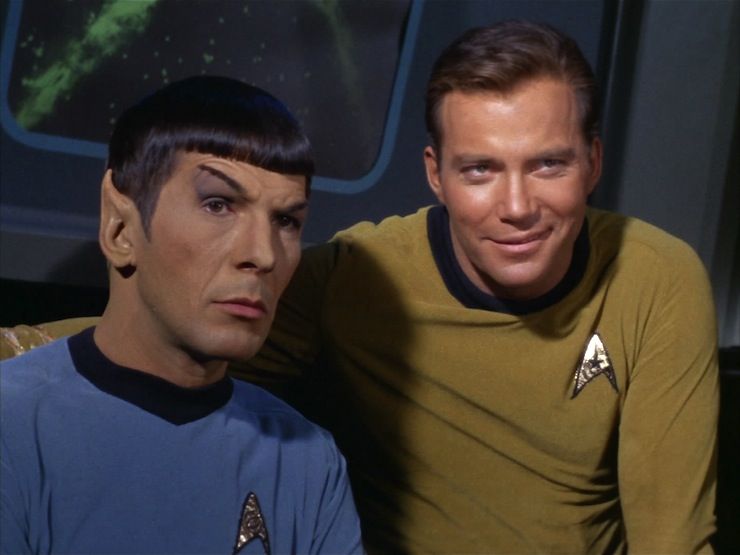
arthropod–>anthropoid
Although the idea of 10 foot tall spear-carrying arthropods is quite a bit scarier :)
I find it hard to credit that he’s never been in command of a mission before – True, but he does insist repeatedly, later in the series, that he has no desire to command the Enterprise. For all those years under Pike, at least Number One outranked him; and these were still the days when Starfleet let captains command the landing parties. Maybe “working up the nerve” to command his first mission is a part of his series-long arc. Maybe he knew he’d suck at it, and “logically” concluded he shouldn’t chance it. And maybe Starfleet is not aggressive about forcing people to push themselves. (Hey, a fan can retcon!)
Love that you highlighted that Uhura moment with the screenshot. In an alternate Trek reality, she is a fine first officer. (Heck, she’s a fine captain in some alternate Trek reality, and Kirk is stuck opening and closing the hailing frequencies!) (And feel better soon, Ms. Nichols!
Do we ever hear about “space normal speed” again? (Followed by an ill-timed dramatic musical sting, that drowns out George Takei’s next line?) That bit always makes me chuckle.
Nice write-up (as ever), especially exposing the revisionism that has gone on about “Kirk the maverick.” The distinction between rule-breaking and autonomy is a helpful one. (Although I wonder about some of the Prime Directive occasions. It seems like we only ever hear about General Order 1 when Kirk is getting ready to ignore it; although I guess you could argue he’s interpreting it as inapplicable – “The Apple” (this culture is stagnating), “A Piece of the Action” (the contamination has already happened, we have to do what we have to do to undo it)…
StrongDreams: DERP! Thanks for catching that. It’s fixed.
—Keith R.A. DeCandido
“Spock speaks honestly to McCoy: the Enterprise will have a bitch of a time finding them since their instruments won’t work in the quasar, and it’s a really big planet, assuming they even know where to look.”
This is the part where they should have been brainstorming ideas for how to get the Enterprise to see them. I was trained in SERE to put out signals for searchers. Surely Spock should have been able to come up with something that could be seen from high altitude.
How would the shuttlecraft have been handy in The Naked Time? It surely would have been handy in The Enemy Within.
@2/Mike: Yes, Spock has no desire to command, yet McCoy insists in this episode that he does (“It’s your big chance”). I really feel for Spock here – he is basically doing okay, he just needs a second-in-command who compensates for his shortcomings, like talking to humans and taking their feelings into account. Scotty is busy repairing the shuttlecraft, so this should be McCoy’s job. Instead, McCoy antagonizes Spock at every opportunity. On top of that, he fusses about Mears who doesn’t seem to need it.
Ferris is right, but he has awful manners. When Kirk tells him that those are his friends he’s looking for, he responds by citing regulations. So no, I don’t regard him as sympathetic at all.
By the way – leaving one half of the men to die and making this a command decision rather than drawing lots? Didn’t we have that last week?
And Gaetano’s job is never specified.
He’s there to get killed, of course.
And how come you didn’t complain once about this being a “quasar”? This phenomenon, whatever it is, is not a quasar, at least how we use the term today.
— Michael A. Burstein
When I heard about the concept of the Straw Vulcan, this is the episode that I thought fit it best.
And as for a “proper burial”, if I had died in that situation I would certainly not want the others to risk their lives giving me a “proper burial”. Besides which I don’t even want a burial. Just leave me out for the scavengers.
I love this episode, the flaws that KRAD points out don’t diminish it for me. It’s one of my favorites, as is Conscience of the King.
mabfan: because they never actually called it a quasar, but rather a quasar-like phenomenon.
JanaJensen: ARGH!
—Keith R.A. DeCandido
Confession: It took me YEARS to figure out that the “Seven” in the title referred to the number of crew members on the mission and was not the actual name and number of the shuttlecraft.
Correction: It isn’t the model shuttlecraft that gets the “Galileo II” modification in “The Way to Eden,” it’s the full-size mockup. All model shots of the shuttle after this episode were stock footage from same.
And I wish they hadn’t numbered it NCC-1701/7. It’s led to the misconception among many fans — and even a couple of pro writers — that the shuttle is actually named the Galileo Seven, that the episode title is simply the shuttle’s name rather than a reference to the seven people aboard the Galileo. The fact that the one in “Eden” is called the Galileo II rather than the Galileo VIII should make that clear enough, but the mistake persists. (Although the one in “Eden” was actually the third Galileo; the second was destroyed in “The Immunity Syndrome.”)
@2/MikePoteet: We did see Kirk upholding the Prime Directive against other violators on occasion, like in “Bread and Circuses,” “Patterns of Force,” and “The Omega Glory.” And as you point out, most of his alleged “violations” of the PD were actually attempts to remove other sources of interference so the cultures would be free to develop on their own again, as in “Return of the Archons,” “The Apple,” and “A Private Little War” (though that situation forced him to settle for a less-than-ideal outcome). The only time he really did wantonly interfere in a culture’s own innate customs was when he prevented Eleen’s execution in “Friday’s Child.” But maybe even that could be seen as a consequence of Klingon interference (although it seems to me Maab would’ve staged his coup even without Kras’s support).
@6/mabfan: Reposting this next bit from a comment I made on the TrekBBS:
As it happens, Murasaki 312 could plausibly be interpreted as a microquasar, something that wasn’t even theorized when the episode was made. At the time, quasars were just mysterious radio sources, their nature unknown, so the use of the term wasn’t too problematical. Later on, we determined they were large extragalactic objects, rendering the episode’s use of the term rather silly; by the ’80s, we’d figured out that quasars were active supermassive black holes at the centers of remote galaxies (it must’ve been by the ’80s, since my college astronomy professor was a quasar expert, and I had the impression that his explanation for them was still a fairly new idea at the time). But by the mid-’90s, we’d developed the idea of a microquasar, a binary system with a black hole component and an accretion disk producing radiation by the same mechanism as a quasar, but on a much smaller scale. These are things that do, in fact, exist inside our galaxy, and could credibly be described as quasar-like phenomena.
(I love it that in the TOS Remastered version of “The Galileo Seven,” the depiction of Murasaki 312 actually resembles a microquasar, while still evoking the color and cloudy quality of the original effect.)
So basically this is an instance where science initially outpaced and discredited an idea from science fiction, then circled back around and made it plausible again.
@6/mabfan: Funny enough, CLB pointed out on TrekBBS just the other day that this is something of a case of science moving past Trek and then coming back around again; there might not be actual quasars anywhere nearby, but we’ve recently (as in within the last 20 years or so) found that there in fact are quasar-like phenomena close enough to Earth for this to not be unreasonable after all. And the graphic the remaster team used for Murasaki 312 does look pretty close to an accretion disc with jets.
@9: Actually, it can be both:
Note the “7” designator on the end, there.
Regards,
zdrakec
Although I like this episode well enough, there are a few things that bother me about it. First, and most importantly, Spock acted reasonably throughout the mission, yet everyone else (except Scotty) acted like he was James Abercrombie.
So the shuttles contain no nonessential equipment or significant redundant systems? I find that hard to believe.
As has been pointed out before, Spock’s “emotional decision” to eject and ignite the fuel was perfectly rational.
Ironically, the statement that prompted a mocking proclamation of Spock’s supposed infallibility contains an error: the first Folsom point was discovered in 1927, not 1925.
Off to deliver the urgently needed medicine at a blistering… warp one?
By the way, Keith, I must protest your transcription of Scotty’s catchphrase. He isn’t saying “cannot” with a Scottish accent; he’s actually saying “cannae” (or “canna”), which is the equivalent word in Scots.
@12/zdrakec: See my comment in #10 (whose posting was delayed for moderation for some reason, perhaps because it had multiple links). The shuttle in “The Way to Eden” was called the Galileo II, not the Galileo VIII. So the shuttle was not “the Galileo 7.”
@13/Vulpes: Kirk chose the slowest possible warp velocity on purpose, so that they’d stay in the vicinity of Murasaki 312 as long as possible just in case. He was bending his orders as much as he could while still obeying them to the letter — further proof of Keith’s thesis about Kirk not being a rulebreaker.
Nope, he ordered warp one after they were safely beamed aboard…
UHURA: Transporters locked in, sir.
KIRK: Activate beams.
SULU: Whatever it was, Captain, it just burned up in the atmosphere.
UHURA: Captain, transporter room just beamed up five persons. Alive and well.
KIRK: Mister Sulu, proceed on course to Makus Three. Ahead warp factor one.
SULU: Aye, aye, sir. Warp factor one.
This episode abused my suspension of disbelief
1. The quasar like phenomenon. I am not sure how much was known about quasars in the late ’60s, but the primary known features when I first read about them were being exceptionally luminous and extremely far away (which probably means that quasars no longer exist as such in the present evolutionary stage of the universe as the observed ones are billions of years in the past). How is something approximating a quasar even in Federation space?
2. You can drain phasers to power shuttlecraft engines. How does that give you an ignitable fuel? Scotty clearly says the fuel lines were ruptured and the fuel lost when his repair attempt fails.
3. What is the in-universe reason for the first officer, chief medical officer and chief engineer to be on this mission? As science officer, Spock makes some sense but what are McCoy and Scotty going to be doing for two days on a ship outfitted like a minivan? It does not seem to have a sleeping area.
Spock’s rant while the native is attacking the ship, I never quite realized before that that was Spock’s version, not under any mind altering influences or hormones, of completely losing his shit.
@1/StrongDreams: As kids, my sister and I referred to the Taurean anthropoids as “Gorilly-Monsters.” As far as I’m concerned, that’s their true name.
@16/Crusader75: At the time the episode was written, it was still being debated whether quasars were distant or not. It was known that their emissions were redshifted, but it was unknown whether that was due to being very far away in an expanding universe or due to gravitational redshifting caused by the quasars’ own mass. They were still quite mysterious at the time, a matter of lively debate, so the episode was actually being pretty topical by presenting their exploration as a matter of some urgency. The writers didn’t anticipate that we’d find the answer as soon as we did.
And I’ve always wondered about the ignitable phaser fuel myself. Never have figured that one out.
@@@@@#10 Ok, so there are things approximating quasars in the galaxy (had heard of x-ray binaries, did not recall they had been likened to quasars). Serves me for not reading the comments before posting.
I thought the shuttles numbering was apparent, Galileo or shuttle #7.
@18/Crusader75: Yeah, but the episode title is not just naming the shuttle. The story is not about the shuttle, it’s about the people aboard it. That’s what the title means. Like The Magnificent Seven or Return of the Secaucus Seven. Or The Fantastic Four or The Dirty Dozen.
Perhaps the energy from the phasers was converted into a simple combustible fuel such as hydrogen?
@18 & 19 – Don’t forget the Mercury 7 ( Alan Shepard, Gus Grissom, John Glenn, Scott Carpenter, Wally Schirra, Gordon Cooper, and Deke Slayton) That was the fist thing that popped into my head and would have definitely registered with the US audience at the time.
Obviously, hand phasers are powered by a liquid chemical-like substance.
CLB @19- @18 is agreeing with you and everyone else, and pointing out the -7 that is apparently the shuttle’s hull number/ ID number, NCC-1701-7. Presumably the Enterprise, NCC-1701, has at least 6 others stowed on the hangar deck.
I believe the issue with the ship number subscript is that the numbers were for logistics , type identification, and reporting purposes while each shuttle would have an individual name. So there could be seven shuttles but each shuttle would have it’s own name probably type related, such as Copernicus, Tycho, Hubble, and Galileo but they wouldn’t use both name and number as that would be redundant. (See DS9 runabouts)
@22/sps49: I mentioned the 7 in the registry number myself, so I certainly don’t need it pointed out to me. My whole point is that the existence of that number helped create the confusion about the meaning of the episode title.
The thing is, there’s actually been at least one published Trek novel (back in the early ’80s, I think) where the name of the shuttlecraft itself was given as “the Galileo Seven.” Not Galileo NCC-1701/7, “the Galileo Seven,” capitalized and italicized as part of the actual name of the craft. Which is simply wrong, because the name written on the side of the miniature and mockup is just Galileo, or Galileo II in “The Way to Eden.” It’s confusing the name of the episode with the name of the ship.
Surely the italics in the title make it crystal clear. It’s “The Galileo Seven,” not “The Galileo Seven” – the shuttle’s name is clearly Galileo and the title is referring to the seven people aboard. It would have been nice if they hadn’t muddied the waters by making the shuttle #7 also, but the italics in the title make the intent clear.
Edit: Ah, my comment didn’t post originally, and now I see Christopher’s touched on the same thing.
@24 – I had thought the title was a dual reference to the shuttlecraft itself and its crew, though perhaps a bit too cute a play by the writers/producers.
@14:
I think I was saying, the name of the shuttle is “Galileo”; this particular “Galileo”, is number 7; so “Galileo Seven” works here both ways – the craft and its crew, or the craft and its designator.
Cheers,
zdrakec
Spock saying he’s going to make the decision on who lives and who dies instead of drawing lots is disturbing when he was just condemning Kodos for something like that the week before. On the other hand, we don’t know how Spock may have chosen. If he had already decided–logically–that he needed to be one of the ones left behind, that makes a big difference.
And the quasar is named after Murasaki! A Japanese woman author from a thousand years ago! This is much better than naming a ship after Malinche. Yes, she’s a famous woman from Mexico, but some people think of her as Benedict Arnold.
As for the attacking aliens: I think the mistake McCoy and Spock both make is that they never know why the aliens are attacking. Maybe they attack all strangers in their territory. Maybe the shuttle is on sacred ground and the aliens are willing to die to drive them out. Maybe they’re outlaws who just robbed the bank and have mistaken the shuttle crew for the posse sent to get them. We don’t know.
What we do know is that they’re unable to communicate with the aliens. I’m guessing they decided not to bring universal translators to examine a quasar. Maybe the small, portable version was still in development.
I’m going to support burying the bodies, though with some reservations. Apparently, they somehow know they have enough time to do this before the next alien attack. Allowing for that, proper treatment of the dead is very psychologically important, part of being loyal to your military unit and knowing they’ll be loyal to you. It’s especially important for soldiers potentially facing death themselves. The marines still remember having to leave their dead behind in World War II.
For Spock, the problem is on three levels. He doesn’t get group dynamics on an emotional level. He has no connection to why this is important to group unity. He is also aware of his weakness and decides to step aside and let someone who does feel that connection deal with it, not appreciating how this further alienates him from the group he’s trying to lead.
“Dreadnaught” and it’s sequel “Battlestations”, by Diane Carey, could usefully be retitled “Lt Mary Sue Saves the Day” and “Lt Cdr Mary Sue Saves the Day Again”. Never mind trying to remap glibertarian economics and politics onto the post-scarcity world of Star Trek.
All that said, they are fun reads.
It’s possible to interpret Kirk’s following of orders in this episode as an example of his rebelocity (rebelliousness?). He checks out the quasar because the administrator pisses him off, and he wants to tweak his nose a bit. That fits with his attitude in The Trouble With Tribbles.
@28/Ellynne – This makes me wonder who I’d leave behind. Mears is an easy one, as we know yeomen are a dime a dozen. Latimer, probably, as navigators probably aren’t much harder to come by. I’m tempted to say Boma because he’s a tool, but that’s not very logical of me. So probably Gaetano, because even though neither his role nor Boma’s are completely clear, Boma seems to be a bit more advanced, even though they’re both lieutenants.
I hadn’t been paying much attention until now, but the Netflix version of TOS is clearly the remastered one. It’s got the pretty quasar-like phenomenon and burning fuel and whatnot.
@27/zdrakec: Except every one of the three Galileos we see is numbered NCC-1701/7, since of course they just recycled the stock footage over and over. And then there’s the anomaly of the third one being labeled Galileo II.
@28/Ellynne: I would submit that the difference between Spock and Kodos is that Spock is the commander of a group of military officers who knew going in that their commanders might have to choose to send them to their deaths, and who gave their consent to that by joining the service voluntarily; whereas Kodos was the governor of a population of civilians, including children, who did not or could not consent to such a thing. As with so many things, consent makes a huge difference.
And I’m not so thrilled by the reference to Lady Murasaki, because the titular hero of The Tale of Genji is one of the most atrociously misogynistic, shallow, and contemptible “heroes” I’ve ever come across. The guy makes James Bond look like an ardent feminist and Bertie Wooster look like a hardworking man of the people.
@29/wiredog: It’s a common mistake to see Dreadnaught! as a “Mary Sue” story. That’s missing the point. It’s actually a “Lower Decks” story — or, in Stargate terms, a “The Other Guys” story. It’s not about a guest character overshadowing the series leads by being impossibly perfect and better than they are at everything. It’s about exploring the familiar heroes and their exploits from a new perspective, that of four of the junior officers under their command, who are trying to learn from them and are three or four steps behind them at every turn. (Not just Piper as the junior Kirk, but Sarda for Spock, Merete for McCoy, and Scanner for Scotty.) It’s basically a Heinlein juvenile set aboard the Enterprise (complete with intrusive libertarian speechmaking). It’s also a lot like the early proposed premise for the animated Star Trek, centering on young cadets who would’ve been the counterparts for their respective mentors in the main cast. Structurally, that’s a very different thing from a Mary Sue story. And at the time, it was a bold experiment — the first attempt to vary the familiar format by telling a Star Trek story from the perspective of new characters, and the first Trek novel written in the first person. It deserves a lot of credit for being innovative. Frankly, I suspect that if Piper had been male, readers wouldn’t be so quick to dismiss her as a Mary Sue.
(After all, it’s a mistake to assume that every story centering on a guest star rather than the heroes is a Mary Sue story. That label refers to that kind of story done badly.)
I will grant, however, that she does exhibit a touch of Mary Sue-ness in Battlestations! I can buy a junior officer helping Kirk expose a massive conspiracy within Starfleet, but having her do so twice in as many months is a stretch, as is having her instantly become part of Kirk’s inner circle.
“the “bad guys”—Spock for not being human enough, Ferris for being a bureaucratic snot—are actually the sympathetic ones.”
They did the same thing in DS9-Waltz. We were supposed to be mad at Worf for sticking to the schedule of protecting a troop transport vs continuing the search for Sisko and cheer for Bashir snarking off at him. In that case and this, one/seven lives are worth more than thousands as long as they are in the opening credits.
@32: pfft. Don’t bother me with contrary facts, I’ve made up my mind.
I’d quibble with the characterization of Kirk as not being somewhat of a maverick. He’s what we always called a “rules lawyer” in this episode. He finds a way to do exactly what he wants to do by knowing all the rules and how to interpret them to his benefit. He follows the letter of the rules but not the spirit. He’s very good at doing this because he knows when NOT to bend the rules. That and most of the time he’s on the ass end of nowhere and there’s no one else to make the call.
Also, was anyone else bothered by the idea that the energy in 7 phasers was enough to send the entire ship and crew (almost) into orbit?
Technically, they did use the term Class-M on the unaired pilot prior to this, specifically the scene where Spock refers to Talos IV’s atmosphere.
This was also an episode I first discovered through reading the James Blish adaptation. Even before actually seeing the filmed version, I already loathed Boma. I was thrilled to learn about the following insubordination charges cooked up by Diane Carey. And I definitely sided with Spock on this one. Someone has to take charge and keep everything in order, because McCoy sure wasn’t doing anything (except of course when he finally snapped at Boma for his behavior). Classic Trek is always worth watching when we get to see Spock’s human and Vulcan sides clashing with one another.
But I actually enjoy this episode quite a bit, if only for the tension it brings by showing them stranded on what should be considered by all accounts an off-limits world. I’d feel sorry for the poor soul who’d have the job of monitoring these people in preparation for an eventual first contact situation (imagine those guys bumping into a duck blind cloaked station, such as the one in Insurrection).
I love this episode, even if it starts the “McCoy badgers an alien co-worker while making fun of his entire culture” trend. :)
@@@@@ 37 – Eduardo: You and I are “we read Blish before seeing the episode” pals of long standing, but please don’t say Diane Carey “cooked up” the charges against Boma, it sounds like he was framed. :)
This is a fun episode, but the characterization of Spock’s actions as a failure of logic always bugged me. Logic gets you from premises to conclusions. If you do it right and your premises are true, it works really well. Spock starts from the (implicit, first mistake) premise that the aliens will themselves behave logically, reasons from that, and winds up drawing incorrect conclusions. What you do then is not (as a screenwriter) say, ah ha, see the flaws in a logical approach, he should have just listened to his heart, but (as the character) go back and question your premises. By not admitting the possibility, which becomes a simple observation, that the aliens are not logical, Spock himself is acting in a highly illogical fashion. But the writers were apparently determined to hang the plot on a hook of “your logic will fail you,” so we wind up being told that Spock was being his perfectly logical self. Bah. But when I look past that it’s an enjoyable hour of TV.
S
Regarding “space normal speed”: I don’t believe we do ever hear that term used again. In the Fotonovel, when Kirk orders space normal speed Sulu is shown with a “think” bubble saying that he suspects Kirk is stalling.
What I don’t get is why, after the shuttle crew is beamed aboard, Kirk orders only warp 1. If he had delayed leaving until the last possible moment, wouldn’t he have to order a faster speed (like maybe maximum warp) in order to make up for the lost time?
Yeah, I was misremembering about the “warp 1.” Now that I remember better, I agree, it was a glitch.
Maybe the gravity and energy of Murasaki 312 interfered with warp engines in a way that limited them to warp 1 until they got far enough away to kick in higher warp factors.
Traveling at warp one happens surprisingly often in TOS (examples include The Alternative Factor, The Naked Time, Arena, Operation: Annihilate!, and Friday’s Child), which doesn’t make much sense on the face of it. Light speed is far too slow for exploring the galaxy on a reasonable time scale.
Many of those examples can be explained as the speed used to depart a solar system or orbit (in Friday’s Child, Kirk says “Take us out of orbit, Mister Sulu. Ahead warp factor one.”) but there are still anomalies. In Arena, for example, after being flung “clear across the galaxy, five hundred parsecs from where [they] were”, Kirk says “Take us back to where we’re supposed to be, Mister Sulu. Warp factor one.” At that speed, it will take them over 1600 years! Amusingly, Kirk was discussing the possibility of a relationship with the Metrons “in a thousand years or so”. They should be ready by the time they get back.
My theory is that it is preferable to ramp up to the higher speeds whenever possible, as it is easier on the engines. Sudden jumps to high warp are reserved for emergency situations. Advances in technology made this unnecessary in the 24th century.
@32/Christopher – I’ll grant you the contempt on Hikaru Genji, but I’m sticking with @28/Ellynne on appreciation for naming the phenomenon after Murasaki Shikibu. That kind of choice in naming is still not particularly common; unless they were actually trying to name it “purple” (the meaning of 紫, murasaki), then I’m damn pleased to have had it named after a Heian-era female writer.
@42 I’ve always explained the warp one orders as the writers not having figured out what speed “warp 1” even was.
Heck, in “The Cage” they prepare for “time warp” speed or something.
I’ve always hated the racist (speciesist?) they treated Spock in this episode. Only Scotty impressed me with his unwavering professionalism.
One thing bothered me though: if the “batteries” had enough power to electrify the hull and shock that giant, twice, then why didn’t they use that power to get off the ground? And if the batteries were useless for lifting off, why are they aboard at all? etc.
The TV show Futurama will establish that a Class-M planet will at least have roddenberries.
Dreadnought is a Lower Deck Mary Sue story. Mary Sue-ish at a minimum, in my opinion.
If a phaser has enough energy to turn persons and person-size objects into plasma/ energy/ whatever, I can relax and accept attaining orbit. Barely.
Comparing Kodos and Spock- Kodos was wrong for the reasons stated, but also because the anticipated emergency was averted; his slaughter was useless (succor did arrive, after the “executioning”). Also, Kodos would be judged as slightly less of an ass if he had included himself in the “necessary” number.
Spock was absolutely correct in stating that the decision on who to leave was his- and I am confident he would have been waving bye-bye to the shuttle’s occupants from the planet. Few decisions are put to a vote by any half decent commander.
With that said, commanders also have limits on orders to subordinates. Not just Nuremburg-type, either. Certain suicide is a tough sell, a requirement I don’t remember from my oath nor the pile of papers I signed.
But was it necessary? Kirk could have (but didn’t; he is only as smart as the show makes him) left several shuttles to continue the search, with plenty of supplies and mutual support. Lacking that, Spock should request volunteers to stay behind with him.
And if nobody volunteers, then everybody stays.
@45/sps49: The problem is that the term “Mary Sue” has undergone so much drift in its definition that it’s become merely a shorthand for “story I don’t like.” It’s lost all utility as an actual term of criticism, because nobody can agree on what it even means.
As I said, the original use of the term was in reference to a fanfiction story that parodied bad examples of stories centering on a female guest star. That doesn’t mean all such stories are automatically wrong. In fact, in ’60s TV, when the aspiration of most dramas was to be as anthology-like as possible, it was common to build episodes around a featured guest star and have the heroes basically just there to support the guest star’s story. We saw instances of this early in TOS, in episodes like “Mudd’s Women” (Eve and Harry’s story) and “Charlie X” (self-evident). Even the second pilot was driven as much by Mitchell and Dehner as by Kirk and Spock. Heck, Roddenberry even pitched the show to executives by calling it a space-based version of Wagon Train, an acclaimed TV drama known for its format centered on guest stars of the week.
So just because a Trek novel focuses more on an original guest character than it does on Kirk, Spock, and McCoy, that doesn’t mean it’s doing something wrong. It’s a perfectly valid storytelling choice by the standards of the era and medium in which Star Trek originated. And yes, such characters in fan and pro fiction were usually female, but that was a perfectly understandable way to compensate for the dearth of female lead characters in the show itself. So that alone shouldn’t earn something the “Mary Sue” rubric.
A “classical” Mary Sue is a character with several specific traits. She is an author-insertion character, an exercise in wish fulfillment. She is asserted to be impossibly wonderful and perfect and lovable, but is not written in a way that demonstrates any of these traits. She outperforms the established lead characters and wins their undying love, but only because they’re written out of character in order to allow her to surpass them.
I’ll grant that Piper is something of an author insertion; the cover artist even modeled the images of her and Sarda on Diane Carey and her husband/co-plotter Gregory Brodeur. But she isn’t perfect and doesn’t outperform Kirk and company; she’s struggling to catch up with them and is in awe of Kirk’s superior abilities. After all, Carey’s work is nothing if not reverent toward Kirk. If anything, Kirk is the Mary Sue in the novels about Piper, rather than Piper being a Mary Sue in novels about Kirk. After all, a Mary Sue is a guest who overshadows the leads. Piper is the first-person lead of her particular subseries, and Kirk is the guest star in her life who’s impossibly good at his job and is ahead of her at every stage.
I haven’t read Dreadnought!, but it would be extremely unfair towards Boma to discharge him because of subordination. He’s very young, he’s frightened, and when he starts making inappropriate comments (“If any minor damage was overlooked, it was when they put his head together”), nobody reprimands him. McCoy even eggs him on (“Not his head, Mister Boma, his heart”). So, the impressionable, expendable youth gets fired, while the experienced senior officers who actually messed things up get off lightly? Nice.
Luckily, there is no continuity between novels – in That Which Divides we meet an older, more experienced Boma, who must work together with Spock and in the end apologizes to him for his behaviour on Taurus II. Spock, of course, tells him that no apologies are necessary.
@47/Jana: Well, there is often continuity among novels, but it isn’t mandatory.
@42
That would make sense in the context of Sulu ‘changing gears’ in The Voyage Home – it took them a while to get to maximum warp.
Besides the oddity of ignitable phaser fuel, a trivial bit from the intro is amusing, given the rocket launches in the public psyche at the time. The shuttle is taking off and Yeoman Mears is reading off the statuses: “Readings normal. Acceleration normal. Phase one separation normal.”
Obviously, a starship shuttle is not a Saturn V.
I never enjoyed the bits where McCoy needles Spock. Somehow, some writers managed to emphasize their differences without making McCoy sound like an asshole, but he’s not very likable in this episode.
Also, the spear deaths are strangely bloodless.
That’s because the spearheads are coated with a special insta-clotting mushroom paste.
The bodies are bloodless, but the spear Spock examines is covered in blood. Go fig’.
—Keith R.A. DeCandido
Well, I hope some novel by one of you great Trek novelists also had that guy Stiles from “Balance of Terror” brought up on charges of insubordination as well, because that guy was a bigger tool than Boma.
iI really like this episode, mainly for the scenes on the Enterprise. Uhura gets lots to do here, acting in Spock’s role, and I was glad to see Sulu after being absent for five episodes. And Ferris is very sympathetic, if not particularly likable. Kirk’s struggle to find his friends and follow orders is palpable.
It’s not perfect, but still a good hour of television.
To whoever asked what Scotty, Spock, and McCoy were doing on the same away mission, why are Kirk, Spock, and McCoy on almost every dangerous away mission, alone? Remember when they visited the planet with the really old guy to collect plants/rocks? Really? The captain of a ship of 400 needs to beam down for that? And remember that they had to walk 2.4km to the site of the plants/rocks even though time was of the essence? WTF are transporters for?
The entire original series requires a permanent suspension of disbelief, as well as a refusal to believe that anyone in 1966 could have foreseen that technology in a few centuries would look somewhat different from already-dated late-1950s technology.
luc: the thing is, this wasn’t the same situation. The cases where Kirk, Spock, and McCoy (and maybe Security McRedshirt to go off and get killed) beamed down was the realities of television. Shatner, Nimoy, and (after season 2 started) Kelley were the three stars, so they got to be the focus. On the other hand, the intent of “The Galileo Seven” was far better — at this point, Kelley was just one of the supporting cast, and the idea was to send Spock with an appropriate team into the quasar. But it wasn’t, to my mind, thought through well enough. McCoy and Scotty in particular just didn’t need to be there for this type of mission. Any medical issues could just as easily be handled by a medtech — anything more complicated couldn’t be handled on the shuttle with its minimal supplies (said minimal supplies being a plot point of the episode) regardless of the skill level of the medical personnel on the team, so why send your CMO? Ditto with Scotty. It just didn’t track quite right….
—Keith R.A. DeCandido
@55/krad: It’s perennially bothered me how Trek series tend to focus on the 7-9 people in the command crew and ignore the hundreds of other personnel who should be doing things. I mean, either Enterprise is supposed to be a science vessel. So when the ship enters orbit of a new planet to do a survey, why do they just send the captain and a few senior staffers down and leave it at that? Why don’t they beam down a dozen science teams to different parts of the planet? There are all these people aboard who never get to actually do their jobs.
I’ve often thought it’d make more sense to do a show about a ship with a small crew, so you don’t have a core group of characters doing all the work that should be shared among hundreds. We’ve seen that done in shows like Firefly and the current Killjoys and Dark Matter, in the first couple of seasons of Andromeda, and in Trek novels focusing on small book-original ships like the da Vinci and the Sagittarius.
Christopher: Yeah, I deliberately chose the Sabre class for the Starfleet Corps of Engineers series because it was the same size as the Defiant, and that had a crew of only 40 or so. I wanted to be able to involve a larger percentage of the crew in the plots…..
—Keith R.A. DeCandido
@57/krad: I just wish you’d called it the Leonardo instead of the da Vinci. That wasn’t a surname in the modern sense, it was just a phrase used to tell him apart from other Leonardos — he was the one who came from Vinci. http://arthistory.about.com/od/davincicode/f/leosname.htm So it’s kind of like referring to Zeno of Elea as “of Elea” rather than “Zeno.”
@10 Sorry to be late to the conversation but you said, ” (Although the one in “Eden” was actually the third Galileo; the second was destroyed in “The Immunity Syndrome.”)
No shuttlecraft was destroyed in the Immunity Syndrome. It survived intact. Different set for the interior though.
@54/luc: “Why are Kirk, Spock, and McCoy on almost every dangerous away mission, alone?”
Are they? Quite often they have at least one or more security guards with them, sometimes a yeoman, and sometimes a specialist, e.g. a historian, an archeology and anthropology officer, or a geologist. It gets worse in subsequent Trek shows, when it’s really just the same seven people who do everything.
The 47 Code of Star Trek is well-known to Trekkies. But it’s more accurate to identify it as the Freemasons do, “A combination of 7 & 4.”
“11 planets in the Talos system, #4 is an M-class.” Captain(7 letters) Pike(4) is part of a 4-member male landing party that encounters 7 males and a female that appear to be survivors of an old spaceship crash. Pike soon imagines himself back on Rigel VII. Later, there are 7 on Talos IV with 4 being human (Pike and three women). – series pilot
When this one hour pilot was reconfigured into the two part ‘The Menagerie’ (S1/Ep11-12, 1966), the Enterprise visits Starbase 11 and Spock responds to him having served under Christopher Pike, “7 years 4 months 5 days”. “General Order 7 prohibits contact of any kind with Talos IV. Violation of this can result in Starfleet’s only death penalty.”
See GOD=7_4 Theory at http://GOD704.wikia.com .
@61/Brad Watson, Miami: Sorry, but Spock said he served under Pike eleven years, four months, and five days. I know that one from memory, but here’s the transcript. After all, the Talos IV incident was 13 years before the episode, and it was assumed at the time that Kirk had been in command of the Enterprise for 2-3 years already. Also, there were six men on the landing party, not four, and I count nine illusory survivors besides Vina. (There are two longer-haired guys on screen right who aren’t in the mid-closeup with Jon Lormer and the six other old guys. Vina emerges from between the group of seven and the group of two.)
And there are 11 letters in the name Christopher — it’s cheating to use “Captain” as Pike’s first name.
There was no “47” connection with Star Trek until Joe Menosky became a TNG staffer and started working it into episodes as an in-joke referring to a club at his alma mater, Pomona College.
I agree with @30. I got the impression that Kirk might have passed right by that quasar if the the pompous prick Ferris hadn’t been so eager to get Kirk under his thumb.
And while they make for interesting plot devices and character interaction, This is the second episode that has been largely focused on rampant bigotry of members of the Enterprise crew against first officer Spock, and it’s already tiresome and unconvincing. I mean, these are Starfleet crewmen, who I presumed have encountered alien species and have been trained in how to behave and coexist with them. They ought to know the basics about Vulcan mannerism and culture, and they damn well ought to act more professionally with regard to a superior officer they are sworn to obey. Every time I see one of them getting all huffy (and sometimes overtly racist) with Spock I want to punch them in the face. Shut up, grow up, and do your damn jobs.
JMHO. :)
I was reading through this for something else, but I wanted to belatedly respond to Brian Dolan in #30 and JohnC in #63. Kirk stopping to examine the quasar, not because he’s under standing orders to do so, but because he wants to tweak Ferris makes Kirk a significantly more despicable figure, because — and I can’t emphasize this enough — THEY WERE CARRYING MEDICINE THAT WAS NEEDED TO SAVE PEOPLE’S LIVES. To be blunt, there is nothing that should have slowed them down, and it’s bad enough that Kirk was sufficiently hidebound to his standing orders that he followed them under these circumstances. To posit that Kirk endangered hundreds of sick people’s lives just to tweak a bureaucrat’s nose turns him into a near-sociopath. And his doing so got several people in his crew killed.
—Keith R.A. DeCandido
You know, it occurs to me that quasars — and microquasars like Murasaki 312 was portrayed to be in the Remastered edition — are very high-energy phenomena that give off intense radiation and thus could be quite dangerous. Maybe the reason there are standing orders to study them is the same reason we study weather systems that could produce cyclones or tornadoes — because if one of them gave off some kind of eruption or radiation burst, it could endanger nearby planets and starship traffic. So that could be the reason for the standing orders to study them, and for those orders even superceding the need to get the medicine to the colony.
@65/CLB: For a starship to just sorta happen across a previously uncharted object that is typically parsec-scale with a luminosity greater than the Milky Way galaxy should definitely qualify as a spatial anomaly worthy of a look-see. :-)
(Although, to be fair the stellar-vs.-galactic nature of quasars wasn’t settled in favor of the latter until the early 1970s.)
@66/Ian: See my discussion way up in comment #10 about microquasars.
@67: Yes, I saw that, but you’re not significantly more likely to find a planet with class-M surface conditions around a microquasar than you are to stumble across a galactic-scale quasar. And surely a microquasar close enough for its gamma- and X-ray outbursts to threaten an inhabited system would have already been noticed and placed under surveillance? They are plenty visible at kiloparsec distances, after all.
As the scope and significance of the term “quasar” itself has already changed a bit since the 1960s, maybe the most plausible way to ‘rescue’ this episode’s usage of quasar is to explain that the term will continue to evolve and it will end up referring to a completely different set of phenomena by the 23rd century. Perhaps instead of quasi-stellar it would be quantum-subspace something-something-something…
Or we can just grab the popcorn and enjoy the pretty zeerust… :-)
IMO the episode’s portrayal of McCoy is worse than its portrayal of Kirk. He repeatedly insults Spock, practically drives Boma into insubordination and even advocates killing the natives (Gaetano: “I say we hit them before they hit us.” – McCoy: “Seems logical to me”). I can condone Kirk’s behaviour by imagining that they have done this quasar surveying many times before and never encountered the slightest problem, although it would still have been nice if he had admitted his mistake at some point. But McCoy is really out of character here.
Is he? It’s a bit more strong than his usual, casual racism, but he is still pretty racist most of the time.
@70/MaGnUs: But he usually doesn’t advocate killing anybody.
@64 – Keith I absolutely agree that to suggest Kirk was risking lives just to tweak some pompous bureaucrat makes his actions despicable here, but I think it’s plausible in light of what we know about the character. You have made eloquent arguments here and elsewhere about Kirk not being the rule-breaking maverick that so many people take him for, but he does have a healthy ego. Yes, he could technically fall back on “I”m just following orders” but I do think he bristled at Ferris’s attitude, and I do think it’s possible that his desire to tell Ferris to shove it was a factor in his decision to ignore Ferris’s objections.
So in essence, I am saying that Kirk may be allowing a personal grudge to cloud his judgment, putting lives at risk by delaying the Enterprise’s ability to deliver medical supplies to a plague-ridden colony. He did exactly the same thing later in the series (“Obsession”). The big difference is that in Obsession, Kirk doesn’t have the “we must investigate all Quasars, even if they’ve been here forever and aren’t going anywhere” justification.
@72/JohnC: No. Just no. There’s a profound difference between “a healthy ego” and a willingness to let people die for the sake of pettiness. The latter is a deeply unhealthy ego — indeed, it’s malignant narcissism, a serious behavioral disorder. James T. Kirk is exactly the opposite of that — he’s the kind of man who risks his own life so others don’t have to, who always acts out of compassion and a drive to protect the innocent.
And his behavior in “Obsession” is not about anything as petty and superficial as personal pride. It’s about stopping a creature that’s killed hundreds of his crewmates before it kills anyone else. Yes, he’s obsessed, but it’s still fundamentally about his regard for other people’s lives.
@73. Not quite sure how Kirk was “risking his own life to protect the innocent” in this particular episode, when its actually Spock and some others he sends to investigate something that poses no threat to anyone, as far as he knows. On the contrary, hes risking countless lives by lollygagging around to investigate a quasar when there are people who need the supplies his ship is carrying so they won’t, like, die.
Nor am I particularly impressed with Kirk’s cost/ benefit analysis in Obsession where he directly defies orders to deliver a vaccine to a dying population so he can get some payback on the big bad cloud thingie alien that he has no reason to think is going anywhere. I still think it was funny that they were shooting torpedoes at it. It’s a freaking cloud. Lol
@74/JohnC: Split hairs about Kirk all you like, but it’s drastically wrong to equate the phrase “healthy ego” with the accusation of a psychopathic willingness to risk others’ lives out of petty personal pride. There is nothing remotely healthy about that.
@74/JohnC: Who said that he risks his life to protect others in this episode? He does so in many other episodes. He’s portrayed throughout the show as someone who puts others’ needs above his own (just like many other TV and film heroes, by the way). He doesn’t have to risk his life in every episode for this to be true.
I’m not sure what you mean when you say that he has “a healthy ego”. That he’s self-assured? But that wouldn’t cause him to “allow a personal grudge to cloud his judgment”. Or do you mean that he has an ego? In that case, I disagree – Kirk questions himself, apologises for mistakes, and goes to his friends for advice more than once.
Sorry, I realize I’m very late to the party but in reading this thread there are a couple of things I just had to bring up. One is that Starfleet though military-like is expressly non-military, as specified by Roddenberry. With that in mind you might see how some of the science types that have only recently made it to the crew of a Constitution class exploration vessel might have come from a much less “serious” or “strict” environment. They may be used to bickering about everything around the lab, an instance where the worst consequence is to start the experiment over. That in my mind was what always justifies the sometimes clearly different attitude toward authority and command structure that is evident across all Trek properties.
The second thing is that the series is set, especially the real original stuff, as exactly that, an exploration of the unknown. We sit here comfortable in our smartphone world with instant information on all the knowledge of humanity (clearly a vain assumption of completeness) looking at a series that was set as the Magellan Expedition or even Sir Frances Drake’s, the assumption that they ” can just come back” is not how that era of exploration worked. Often you would happen across something and that was the only time ever in your lifetime. Perhaps they have the order about gathering data so that any other time a Starfleet, or other ship for that matter, passes a similar navigational hazard they will be safer for it.
This second also explains why Scott is along, whether of his own choosing or by orders. Clearly being one of the preeminent engineers in all of Starfleet he likely wants to be there to observe the effects of the disturbance on the shuttle’s systems. The up side is Scott also had always had a bit of premonition for when things will go bad mechanically so that besides the reading he wants to take he knows that if anything goes wrong in this large area of undetermined navigational hazard then he might just be the guy to handle it. Surprise, surprise, good ol Scotty was in the right place at the right time once again!
I also wanted to mention that I’m 100% with you on the “Kirk as the ideal” thing with his rarely actually breaking rules. Even including the Maru simulation he’s not clearly breaking rules. The test’s purpose being to evaluate how a commander handles failure. The result in Kirk’s case is simply that he clearly understands the point but will do absolutely anything to avoid that failure. Just the kind of guy you want exploring an unknown frontier. To me Kirk has always been Roddenberry’s tribute to American Exceptionalism. Follow the rules as long as you can but solving the problem is at times more important, as well as many other things that make me wish there were more Kirks in our leadership nowadays.
Thanks for the entertaining thread, especially the civility here!
Quoth captaingriffin: “One is that Starfleet though military-like is expressly non-military, as specified by Roddenberry.”
First off, thanks for the cogent commentary. And it’s never too late to comment, so no worries there. :)
Secondly, the quoted statement doesn’t really apply here for two reasons. 1) Roddenberry didn’t specify that until two decades later. It wasn’t until TNG came around that he started insisting that Starfleet wasn’t a military organization. 2) Roddenberry was utterly totally thoroughly full of shit, or forgot by the 1980s that “military” and “militaristic” are two separate words. Starfleet has a rigid rank structure and courts-martial whereby they enforce their internal rules. By definition that makes it a military. To deny that is to deny reality.
As portrayed in every incarnation, but especially in the original series, Starfleet was 100% a military. And Boma’s behavior was at best unacceptable and at worst insubordinate.
—Keith R.A. DeCandido
A quote from the 1967 Writers’ Guide:
“Is the starship U.S.S. Enterprise a military vessel? – Yes, but only semi-military in practice — omitting features which are heavily authoritarian.”
Boma was a frightened young man. I find McCoy’s behaviour worse.
captaingriffin: As to your second point, that is true, but to my mind it’s superseded by the fact that they’re supposed to be delivering emergency medical supplies. That’s a mission that should override anything else.
—Keith R.A. DeCandido
I want to add some thoughts on the more or less military nature of Starfleet.
When the question comes up whether Starfleet is military or not, I always think that both sides have a point. On the one hand, as krad points out in comment #78, they have military ranks and court martials. They also have military exercises and fight wars. On the other hand, they are totally unlike any contemporary military. Their main task is space exploration. They ferry diplomats and supplies, check in on remote colonies and answer distress calls. They wear uniforms that are colourful, comfortable, even fashionable. In “The Squire of Gothos”, Jaeger says: “I’m a scientist, not a military man”.
For me, that’s a big part of Star Trek’s appeal – the closest thing this future society has to a military is a bunch of scientists in bright clothing on an exploratory mission, totally devoid of any Aliens-style machismo, some of whom don’t even consider themselves “military men”. Episodes like TNG’s “The First Duty” or VOY’s “Learning Curve” bother me because instead of exploring this difference, they make Starfleet look like a contemporary US-American military. It feels incongruous and lacks imagination.
I was delighted when I discovered in the Writers’ Guide that the TOS writers had actually thought this through and come up with a term for it – “semi-military”. That’s perfect! They go on to explain that in Starfleet, people don’t salute (or, presumably, shout “Captain on the bridge”?), and that “we are not aware of ‘officers’ and ‘enlisted men’ categories” – I guess this suggests a flatter hierarchy, which is fitting for an organisation like the one described above.
Since Starfleet is only “semi-military”, I find the idea presented by captaingriffin in comment #77 makes sense. I used to think that Kirk runs an unusual ship when he lets Spock get away with pretty much everything and allows McCoy to criticise him on the bridge, but perhaps this is simply how Starfleet works.
Jana: Minor pedantic point–it’s courts martial, not court martials. “Court” is the noun, “martial” is the adjective, so “court” gets pluralized.
Less pedantically, it’s worth pointing out that there isn’t a single contemporary military that looks anything like the military of 300 years ago, either.
—Keith R.A. DeCandido
@82/krad: Oops. I’ll try to keep that in mind.
Concerning the less pedantic point, you’re right, of course. One of the things I like about TOS and early TNG is that the writers really tried to make up a world where some things are different. What I meant is that merely saying Starfleet is military can lead to wrong assumptions, and that comment #77 still works if you replace “non-military” with “semi-military”.
When I watched Star Trek as a kid, I never even noticed that Starfleet was supposed to be a military organisation. It hit me years later. Although this may be partially due to the fact that the German dubbed version downplays the military aspects even more.
The thing is, there are different aspects to the military. It’s not all about fighting. There’s the Coast Guard, there’s the Army Corps of Engineers, and there’s all the stuff militaries do in peacetime like disaster relief, medical assistance, scientific research, and so on. I’m aware of at least one military in the world that’s explicitly pacifist, the Japan Self-Defense Forces, which exist strictly for defending against attack and threats to internal security, as well as peacekeeping and other non-aggressive missions abroad. (And, of course, defending Japan against giant monsters. Although there are a couple of kaiju movies — Gamera: Guardian of the Universe and last year’s Shin Godzilla — in which it’s a plot point that the SDF can’t legally open fire on a monster unless it fires first.)
So it seems to me that Starfleet is basically equivalent to the JSDF, a military that exists strictly for defense, peacekeeping, and aid missions — albeit crossed with something like NASA or the ESA, an organization dedicated to science and exploration. I’d say it’s that hybrid nature of Starfleet, something that’s both scientific and military at the same time, that gives it such a flexible attitude compared to pure militaries. ST: Enterprise laid the groundwork for this by showing that Starfleet was initially a more strictly NASA-like organization — using rank structure but otherwise considered non-military and having a relaxed, casual attitude among the crews — that later folded in a more military aspect (the MACOs) in response to the threats it faced in the course of exploration. So the military side has always been secondary.
@84/Christopher: The (West) German military also used to exist strictly for defense, but this changed somewhat in the 1990s.
It’s nice that Starfleet started out as a NASA-like organisation.
All things considered—I was watching “Galileo Seven” today and tonight as part of a Star Trek mini-marathon, and I suddenly realized something about Spock. Maybe it’s because he’s half-and-half—but he can be a big tease, and he certainly was that at the end of the episode! No matter what anyone else said about his desperation move, jettisoning and igniting the fuel, and all that, he replied with the straight-faced logical answers he so often did, and the rest of the crew suddenly realized he was teasing them and burst out laughing. His sense of humor had many facets to it, and we would see more of that later in the series.
Deliver emergency supplies far away, when crew are missing nearby? If only the ship could be split in two, with half capable of warp flight, and the other half with sensors and transporters.
Of course, Ferris would lose his stateroom and have to settle for a shared room. Still, he’d have a pool and bowling alley to use.
As for the “warp one” business, I assume that’s always the first step to any warp speed, sometimes specified and sometimes not.
Spock’s line “I for one do not believe in angels”, is sure going to play differently as this season of Discovery goes on.
A bit late to the party, but I wonder whether there are two remastered versions of this episode, because no one mentioned an odd effect in one scene, when a thick (badly inserted) fog obscured one of the dead officers lying on the ground. Reason: the (today?) viewers should not see the spear wound in the back of the man.
Is there a kid‘s friendly version and another version (uncensored)?
Or was this obscuring effect already in the original version? I doubt it because I vividly remember the cruel view (I was ten, when it first aired here in 1973).
Michael: no idea, since I’ve never seen the remastered versions.
—Keith R.A. DeCandido
@89/Michael: No, the badly inserted fog was always there. There’s no way 1960s censors would’ve allowed showing a graphic spear wound; restrictions on onscreen violence and gore were much tighter then, not looser.
Krad: “…because that’s totally the appropriate thing to do after a mission where two people have died.”
Three people died. Two on Spock’s original mission and then an additional person killed as part of the rescue attempt.
It sure does seem like a lot of people being sent on the shuttle. I’ve never seen a party on a shuttle that large before on Star Trek since then. I think they could have scaled it back to just 5 characters: two regulars and three guest characters.
I sure hope Strange New Worlds remembers that this is Spock’s first command mission and doesn’t try to retcon something else into Spock’s history where he’s in command of Pike’s Enterprise or an away mission.
There is definitely an irony in having Boma, an African-American character, be the one to demonstrate such ugly bigotry towards Spock, but that just shows how fallible humans are regarding displaying prejudice when you think certain people should know better. Oftentimes in our history and our present, one minority doesn’t see the parallels in their struggle for equality that another minority is facing or they don’t think it rises to the same level of importance. I remember when I was a kid and I switched elementary schools and I attracted the wrath of some bullies simply by being the new kid. Now “new kid” isn’t exactly a minority group as we tend to think of it, but my chief tormentor was a Black girl and I recalled thinking to myself “shouldn’t she know better?” Of course, children are often ignorant, but now in the present I often see examples of adults who should know better but can’t quite make that breakthrough.
Anyway, I thought this was a very good episode. It was a good lesson in command for Spock as well as a good lesson to him in that things don’t always play out in a logical manner. There was a lot of tension down on the planet and “the giants” felt like a very scary and credible threat. It was pretty funny in seeing Spock questioning why the aliens weren’t reacting logically literally as he and his team are being attacked. And the bridge crew laughing on and on forever to make fun of Spock at the end was eye rolling. I mean a chuckle would be okay but that was over the top. It was like a Dr. Evil laugh from Austin Powers.
Still, very enjoyable episode and I’d give it a 7.
@92/garreth: Good points, although personally I find that this episode suffers from an unlikeable McCoy. He is not yet the humanist he becomes later on.
Since there is no more racism among humans in the 23rd century, Boma shouldn’t know better unless he paid attention in history class. But it’s still ironic from the audience’s point of view.
This has no bearing on your argument, but I prefer to think that Boma isn’t African-American but African, like Uhura and M’Benga. I like it when the crew comes from all over the world.
@92/garreth: “It sure does seem like a lot of people being sent on the shuttle. I’ve never seen a party on a shuttle that large before on Star Trek since then.”
That’s because they didn’t do any other episodes that were primarily set aboard a shuttlecraft. They just used shuttles as means of getting characters from one place to another. In this case, the shuttle was the primary setting of the episode, so of course it needed a larger cast, especially with two sacrificial victims required.
I wonder if maybe the episode was inspired by Hitchcock’s Lifeboat, a clash of contrasting personalities in a tight survival situation. In that film, there were nine people in the boat.
@94/CLB: It wasn’t a complaint, mind you. Just that I found it a bit odd seeing as I grew up on TNG-era Trek and am working my way backward. And I also found it amusing like it was a class field trip on a mini-bus or a family packed into a minivan. The large size of the group made it ideal for squabbling and different combinations of people squaring off against others although it never devolved into a Lord of the Flies type of scenario which would actually be kind of cool to see on Star Trek.
Personally I like to think that Boma came to Spock later and said that while he stood by his opinions he realizes now he was way out of line in how he expressed them. To which Spock replies that he realizes he should have given more consideration to the emotional nature of his officers and they need not speak of this again.
@96/Roxana: That’s a nice scene. I would also like McCoy to invite Boma to a glass of brandy and tell him that senior officers get frightened too, and while he generally isn’t a fan of Spock’s logic either, none of them showed their best side on the planet.
@97, JanaJansen, That is definitely true!
“Galileo 7” is not a great episode, but it’s a good one because it depicts the difficulties that Spock faces as a commander over “emotional humans.” Spock is widely disliked and resented by the crew (at least when he’s in charge) and they openly mock, ridicule and even threaten him (Hello, Mr Boma!). If Kirk was in charge of the marooned shuttlecraft crew, things would’ve been much different.
The word “logic” doesn’t mean what this script thinks it means.
I have a hypothesis as to why Scotty and McCoy were on the Galileo: Kirk sent them because Ferris was driving them crazy.
Let’s say Ferris was spending his days on board making a loop from the bridge counting down (“Eighty-seven hours, forty-four minutes, Captain!”), to sickbay checking on how the medicine is stored, to engineering harping about the antimatter. And you know he wouldn’t speak to some duty officer; he would insist on the chief engineer and chief medical officer every time.
So Kirk, seeing an opportunity to give his guys a break assigned them to the shuttle mission. “It’ll be a milk run. Enjoy!”
@101 If that were the case, Kirk would have joined them.
@102, I think Kirk might have been tempted, but ultimately couldn’t justify leaving the ship. Plus, I don’t think he would have wanted to pass Ferris on to anyone else.
nms72: I don’t agree with that interpretation, but then again, I’m the guy who thinks that the asshole in this episode is not Ferris, it’s Kirk, since Ferris actually cares about getting medicine to sick people………..
—Keith R.A. DeCandido
@104, One-hundred percent, Ferris is correct that delivering the medicine is more important than investigating quasars and quasar-like phenomena. There are shots, however, where Ferris looks smug and almost gleeful when he hears about the shuttle accident. I could see picking a cramped shuttle over being around that guy.
That’s why this episode is so frustrating; there had to have been a better way to create a ticking clock than an already-occurring emergency.
@105/nms72: “One-hundred percent, Ferris is correct that delivering the medicine is more important than investigating quasars and quasar-like phenomena.”
See my thoughts in comment #65 above. Given the intense radiation bursts that microquasars would probably give off, it could be a matter of considerable urgency to monitor their activity closely, just like it’s important to monitor tropical storms and hurricanes.
@106, That’s an interesting idea, thanks for pointing me to your original comment. I’ll definitely apply the “space hurricane theory” to the next time I watch the episode.
Reviving this thread because I watched this episode last night (courtesy of the Horror Channel here on Freeview in the UK) and the thing that struck me was:
Right at the end, Uhura reports “Captain, transporter room just beamed up five persons. Alive and well.” Kirk looks away, a smile on his face, and orders, “Mister Sulu, proceed on course to Makus Three.”
Surely what he should have been saying was: “Five? There were seven when that shuttle left. Lieutenant, find out who’s died and contact their next of kin.” For all he knows, his bestest friends in the galaxy, McCoy and Spock, might be amongst the dead. Bear in mind that that there has been no verbal communication between the Enterprise and the Galileo since it left, so up to this point Kirk is unaware that anyone is dead.
@108, Ensign O’Neil with the shuttlecraft Columbus got a spear through the body, according to Lt. Kelowitz. Maybe five Galileo survivors was more than Kirk hoped for.
I’ve always liked this episode because it highlights the continual problems Spock faces in a ship full of emotional, impatient humans. As a commander, and under stress and danger, the humans’ underlying dislike and resentment of the Vulcan First Officer comes out (“I’m sick and tired of this machine!”). Can you imagine Boma talking to Kirk that way if Kirk was in charge of that expedition? The reviewer Keith pointed out some of the fallacies in the plot (they should have sent the supplies to the plague colony and studied Murasaki later). I actually liked the fact that we never got a good clear image of the creatures on Tarsus (obviously, to save costs). As a kid, the fact that we could not see them too well made them even more frightening.
Ferris’ motivations may be sympathetic, and he is clearly correct, but his attitude robs him of any sympathy I might feel for him. He actually smiles a little when something goes wrong and he’s proven correct that Kirk never should have sent the shuttle out.
I thought the point of the episode was that Spock was wrong and his strict adherence to logic was not a good fit for command. Two people died and he didn’t care and made a bunch of cold decisions about how to proceed in the mission. His way of leading reminded me of someone with Asperger’s trying to deal with people and doing a poor job of it. The only thing that saved them was in the end that he abandoned logic.
And I agree the ending was kind of disturbing how 3 people died on the away missions and everyone on the bridge is having a laugh.
Overall it was a decent episode.
@112/Tim Kaiser: I don’t think the episode was so simplistic as to say that there was a clear-cut right side and wrong side. Spock made mistakes in managing his first command (as it was presumed to be at the time, though I doubt Strange New Worlds will stick with that), but Boma was inappropriately insubordinate to a superior officer, and neither side did a good job trying to understand the other. It wasn’t about one side being right or wrong, it was about a clash of personalities and viewpoints, and about imperfect characters learning from their experiences. It was about a tense situation bringing out the worst in everyone and thereby creating drama.
To say that Kirk never should have sent the shuttle out implies that the Captain must be prescient and never take any risk whatsoever. I’m sure he had sent out hundreds of shuttle missions for exploration and study, as his standing orders required. I saw no information that would imply that he should have magically known this was the one he should not have sent out.
Kirk was making the correct decision. The rendezvous was five days away. The rendezvous point was 3 days away. There wasn’t any rational reason why he couldn’t spend one or two days fulfilling his normal orders.
I always found this episode grossly overrated. I can see the appeal in the very early days when Spock became the breakout character (and I mean in 1966) but the behavior of the shuttle crew is unprofessional beyond reason, excepting Spock and Scotty.
Spock is clearly commanding this mission very poorly, but that is incompetence, not a lack of professionalism. (And how do you become second in command of a starship without having every commanded anybody??)
It’s maddening that the script confuses a guess (Spock’s belief the giants will be frightened by phaser beams) and a calculated risk (ejecting the fuel to make the shuttle much more visible from space) as “emotional”. That’s obviously quite wrong and quite key to the plot, so big fail.
Boma was unbelievably insubordinate, and I’m glad he was court martialed.
IMHO, Bones should have been brought up on charges as well. As a senior officer, he not only fails to correct Boma, he eggs him on. It’s one thing when Bones and Spock are going at each other alone or with other senior officers, but not with subordinates in a critical life and death scenario! Spock was obviously struggling and needed Bones’s help, not more endless criticism.
@53, Stiles vs Boma:
Should Stiles have been court martialed for his behavior in “Balance of Terror”? I don’t know, I don’t see it as anywhere near as bad as Boma here. Of course, that’s in part because he was repeatedly corrected for his behavior instead of being egged on. He definitely needed some disciplinary action and I think it would be a long time before he sat on a bridge again.
Oh and the officer there only to act like a child and literally show her panties was at least not insubordinate.
@115/Sillyk: I don’t get what you’re referring to in your last paragraph, but nobody showed their panties in TOS, nor would ’60s censors have allowed them to. The female “miniskirt” uniforms were more like mini-skorts or culottes, sort of a leotard design with skirt flaps added on.
Re: “Do we ever hear about “space normal speed” again?”
While we never hear that specific term again, we hear a synonym for it all the time in TOS: it means non-warp, i.e. sublight, i.e. impulse power.